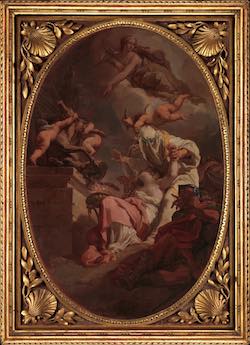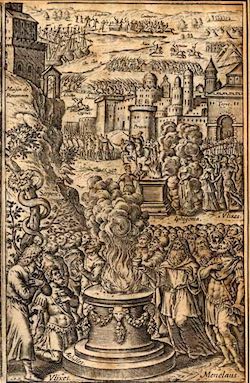Topic: 2. Sacrifice and religion: Comparisons, Antiquarians, Anthropology (16th-18th Century)
Religious sacrifices across various cultures and contexts sparked widespread interest in Early Modern Europe. As Christianity expanded into regions inhabited by "infidels" and "pagans", Europeans encountered a diverse array of sacrificial customs, ranging from the Sati rituals in India to the Aztec sacrifices in the Americas. This cross-cultural exposure captivated a wide audience, including theologians, philosophers, political thinkers, antiquarians, orientalists, missionaries, poets, artists, and even the general public. These encounters broadened the European understanding of sacrifice and led to a critical reassessment of classical and biblical sacrificial rites. This section includes:
- Sources: A selection of early modern printed materials, which include descriptions of the Americas, Asia, and Africa, alongside antiquarian and philological studies on religious sacrifice in classical antiquity and beyond. It also presents early modern works of ethnological observations and the first attempts to compare different sacrificial practices in various traditions and contexts, laying the groundwork for disciplines like the history of religions and anthropology.
- Iconographic Representations: A rich collection of images from the 16th to 18th centuries, illustrating a range of sacrificial rituals and practices as seen in different cultural and geographical contexts.
- Related Bibliography: An extensive bibliography spanning scholarly works from the 19th to 21st centuries, providing contemporary analyses and interpretations of these early studies and observations.
Trattato de gli instrumenti di martirio, e delle varie maniere di martoriare usate da’ gentili contro christiani, descritte et intagliate in rame. Opera di Antonio Gallonio Romano sacerdote della congregatione dell’oratorio. Con la tavola nel fine di tutte le cose piu notabili […]
Rome: Ascanio e Girolamo Donangeli, 1591.
The Sacrifice of Iphigenia (1789)
Palazzo Gnudi Scagliarini, Bologna
Why do we call the Holocaust 'The Holocaust'?
in: Shoah: The Paradigmatic Genocide, pp. 51-66
Lanham: UPA, 1994.
Funerary dramas and ritual killing in the Slavic World Written sources and archaeological realities
in: Human Sacrifice and Value. Revisiting the Limits of Sacred Violence from an Anthropological and Archaeological Perspective, pp. Chap. 8
: , .
A Pagan Sacrifice (1526)
National Gallery, London
Il sacrificio fra antropologia e Bibbia
in: E il Verbo si è fatto pane : l'Eucaristia tra Antico e Nuovo Testamento, pp. 15-25
Assisi: Cittadella, 2009.
The space of idolatry: reformation, incarnation and the ethnographic image
in: Res, v. 41 (2002), issue --: pp.72–91.
La Dokimasia des victimes. Notes sur une iscription d'Entella
in: Annali Della Scuola Normale Superiore Di Pisa. Classe Di Lettere e Filosofia, v. 14 (1984), issue 3: pp.845–848.
Deep Play: Notes on the Balinese Cockfight
in: The Interpretation of Culture: Selected Essays, pp. 412-445
New York: Basic Books, 1973.
De Turcarum ritu et caeremoniis
Antwerp: Gregorium Bontium [Goris de Bonte], 1544.
An Irish ritual of kingship: the sacrifice of a white mare and preparation of a stew, in which the king bathes and which his supporters ea (ca 1196-1223)
British Library, London [ms Royal 13 B. VIII, fol. 28v]
Muhammad and the Formation of Sacrifice
Frankfurt: Peter Lang, 2014.
The Sacrifice of Isaac (1562)
from: Project on engraved sources of Spanish colonial art
Sotocoro, Temple of the Franciscan Ex-Convent of La Asunción de Nuestra Señora, Tecamachalco, Puebla, Mexico
Victimae Humanae, complexa Modos, Ceremonias et Tempora quibus olim Homines Diis suis immolabant et humanum sanguinem libabant
Groningen: Dominicus Lens, 1675.
Sierra Leone Muslims and sacrificial rituals
in: Sierra Leone Bulletin of Religion, v. 2 (1960), issue : pp.27-32.
Soteriology and the end of animal sacrifice
Eugene, Oregon: Wipf & Stock, 2018.






